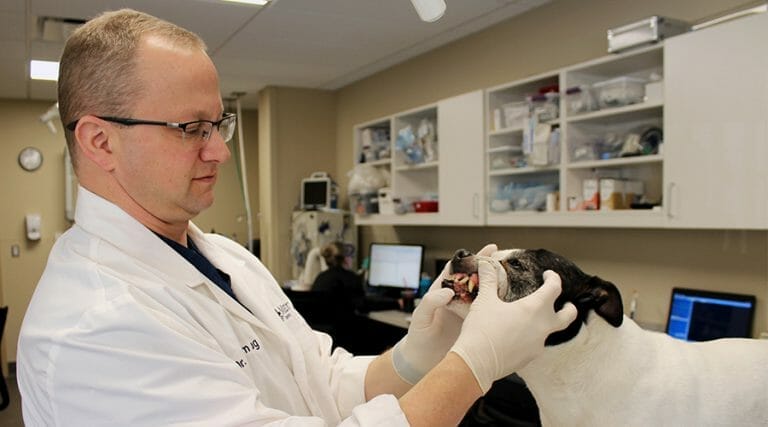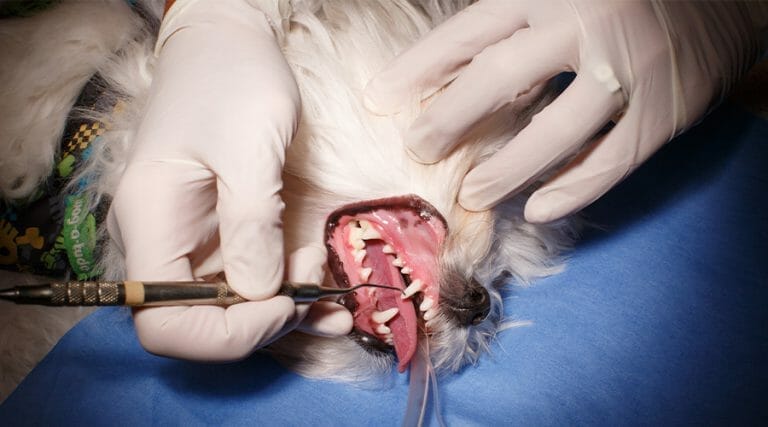
Think about your last trip to the dentist. You had to sit still with your mouth open for 20-30 minutes while a dentist scraped at your teeth with sharp, metal objects. You might have even experienced some anxiety before or during your visit. If this sounds like you, you’re not alone as a study from DentaVox showed that about 60% of people are afraid of going to the dentist.
Individuals experiencing anxiety when facing a trip often opt for procedures with some form of anesthesia. Such is the case for our pets. Not only does anesthesia eliminate fear and stress for your pet, but professional dental cleaning under anesthesia is also more effective.
Keep reading to learn more about the benefits of regular, professional dental cleanings.
Professional Cleaning is Most Effective in Preventing Periodontal Disease
Maybe you brush your pet’s teeth regularly or provide them with dental chews that help clean teeth. That’s great, but it is not enough to protect your pet from periodontal disease. Periodontal disease is the most common clinical disease in adult pets even though it is completely preventable. It is caused by a bacterial infection that grows beneath the gum line and destroys gum tissue, roots, and bone structure. Because the bacteria are growing beneath the gums, you cannot see it just by looking in your pet’s mouth. And you cannot reach it just by brushing their teeth.
Signs of periodontal disease include bad breath, bleeding or red gums, loose teeth, problems picking up or chewing food, bumps, or lumps in the mouth, receding gums, and bloody saliva. Untreated, periodontal disease can be painful and cause your pet to lose teeth. Dental disease can even lead to other health issues such as heart disease.

Professional Dental Cleanings with Anesthesia Are Less Traumatic and Allow for a More Complete Cleaning
You may have been offered anesthesia-free cleanings for your pet. It may sound like a good idea for those who are nervous about their pet having anesthesia and it is less expensive. However, anesthesia-free cleanings can cause more harm than good.
Anesthesia-free cleanings:
- Can be scary for your pet. During an anesthesia-free cleaning, your pet cannot understand a doctor telling them to relax. To keep their mouth open and their body still, they would be restrained which is stressful and often uncomfortable for your pet.
- Prevent the veterinarian from fully cleaning your pet’s teeth. The teeth are scraped which may help them look whiter on the surface. But white teeth do not necessarily equal healthy teeth. All that yucky buildup you can see on the teeth is also growing below the gum line. Those areas that you cannot see need to be cleaned for your pet to be protected. Those areas cannot be reached while your pet is awake.
- Cause future issues. Without a full picture of what is happening, damage to roots and bones may go undetected and continue to get worse. Scraping without polishing teeth also leaves rough edges that leave bacteria an inviting place to attach to and grow.
Professional Dental Cleanings are Comprehensive
A comprehensive dental cleaning starts with an initial exam of your pet’s mouth while they are awake. The veterinarian will examine the teeth, gums, and mouth to get a general idea of the overall condition. Next, they will perform bloodwork to ensure your pet is healthy enough for anesthesia.
For the cleaning, your pet will be given general anesthesia that puts your pet in an unconscious state, so they do not feel any pain. Given and monitored properly, anesthesia is very safe for your pet. The American Veterinary Dental College provides a helpful list of questions about anesthesia procedures that you can ask your veterinarian in advance.
During the cleaning, the veterinarian will take radiographs of your pet’s mouth. This is like the kinds of X-rays you get at the dentist. They help the veterinarian see what is happening beneath the gum line and if there are any problems with the bone structure, infections, or other issues. Next, they fully clean the teeth and remove plaque and buildup below the gum line. Then, they will scale or scrape the visible part of the teeth. Finally, they polish your pet’s teeth which leaves the surface smooth and makes it harder for bacteria and plaque to build up.
After recovery, your pet can go home and typically resume normal activity right away if they have not had additional procedures done. Regular dental cleanings usually only take a few hours from start to finish.

Protecting Your Pet’s Dental Health Requires At-Home Care, Too
The biggest things you can do to help protect your pet’s dental health are brush your pet’s teeth at home regularly and ensure your pet gets a proper checkup and cleaning annually. For at-home care, be sure to use toothpaste and products that are made for pets. The Veterinary Oral Health Council provides a list of acceptable products for cats and dogs.
For cleanings, avoid offers for anesthetic-free cleaning. The American Animal Hospital Association and the American Veterinary Dental College encourage anesthetized cleanings.
Keeping Teeth Healthy Takes a Team
Overall, the benefits of a complete cleaning outweigh any potential risks from anesthesia for most pets. Be sure to talk with your veterinarian about your pet’s dental health at your yearly visits. Your family veterinarian is there to provide preventative oral treatments. However, you may want to seek a referral to a Veterinary Dentist for help with more advanced care. Our MedVet Dental and Oral Surgery specialists provide comprehensive cleanings, tooth extractions and repairs, and a variety of other services to keep your pet’s teeth and mouth healthy and pain free.